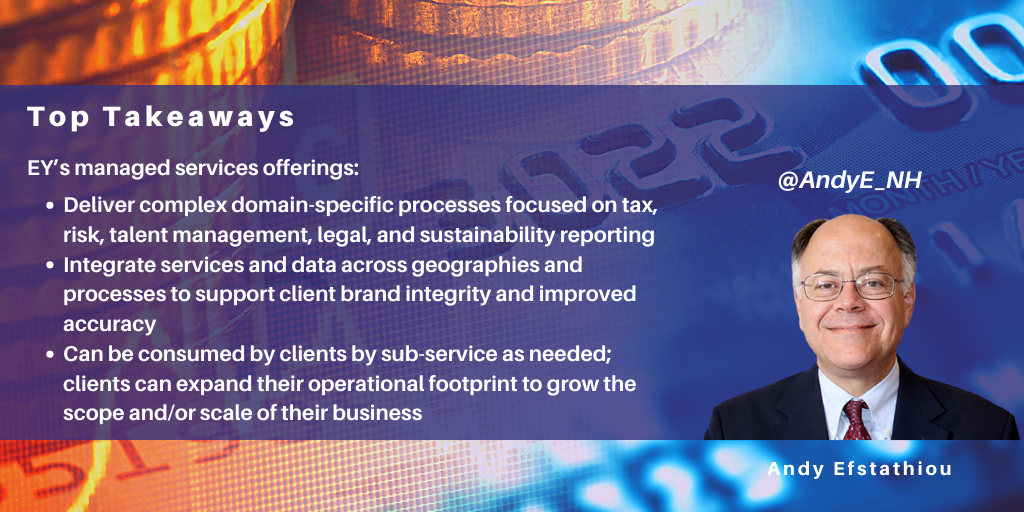Search posts by keywords:
Filter posts by author:
Related NEAT Reports
Other blog posts
posted on Jun 27, 2022 by Andy Efstathiou

I recently attended the EY Managed Services Analyst Summit. EY’s managed services business just finished a gangbuster year, growing 30% over the prior year, with some sub-segments growing at rates up to 150% y/y. Managed services is EY’s fastest growing line of business, justifying EY’s 12-year-long commitment to this business. Here I look at EY’s managed services business, why it is satisfying a need in the market, and where it is going.
EY’s managed services offerings
The managed services business is expanding EY’s services offerings from advice and compliance to operations delivery services. EY’s managed services business differentiates itself from traditional BPO services by delivering “insight and enablement”. This means they wrap in consulting services and a technology platform (delivered using a microservices architecture) to provide higher value processes requiring domain knowledge and advanced functionality. EY employs three key competitive differentiators in these offerings:
- Domain expertise: drawing on its industry and process practitioners for best practices and each market’s custom requirements
- Integration: drawing on EY’s global delivery capabilities, including the EY fabric, proprietary IP, and alliance partnerships
- Orchestration: the delivery frameworks, infrastructure, and platforms to orchestrate consistent delivery across multiple markets and sub-industries.
The event showcased five of EY’s core managed service offerings including:
- Finance and Tax:
- Customer tax operations and reporting
- Enhanced corporate reporting and compliance
- Managed services and treasury
- Finance managed services
- Financial planning and analysis
- Tax and finance operate
- Risk and Cyber:
- Cyber operations
- Financial crime
- Risk managed services
- Forensics managed services
- Internal audit
- Compliance as-a-service
- Talent:
- Payroll
- Global mobility
- Legal: Legal managed services
- Sustainability: ESG reporting.
Finance/tax and risk/cyber are the most mature offerings. The most recent offering is sustainability, which was started two years ago. All offerings draw on resources from EY to support their delivery. For example, clients requiring LIBOR loan contract novation buy legal managed services. Lawyers and AI in legal managed services review contracts, but compliance services and GAP analysis are sourced from the risk/regulation practice. The most important shared service is data analysis and management. Data management capabilities support all managed service offerings (and all EY offerings).
Managed services delivery
Critical to the delivery of value is EY’s ability to deliver across enterprise silos, both geographic and line of business. EY’s consistency of delivery across global silos enables clients to build and maintain brand integrity across products and markets. Customizing delivery for each client requires multi-year commitments for most managed services offerings. Client retention is high and over half of new engagements are sole sourced, typically from existing EY clients.
EY enhances and delivers its managed services with its partner ecosystem. EY relies on a smaller, focused set of partners to co-innovate, create, and deliver its managed services. The three partners that presented at the event are Microsoft, SAP, and ServiceNow.
In each industry, EY works with additional partners to develop industry-specific offerings. For example, in BFS, EY works with additional partners including Pega, Experian, and Finacle.
Looking ahead
The two areas of focus for alliances over the next several years are optimizing existing offerings and developing new offerings. Developing improved data management techniques across markets will be a key focus.
EY managed services are targeting large global enterprises, many of whom are looking for support in their smaller markets, but eventually rolling out the services to home markets. As organizations are adapting to the digital world, the internal buyer is often changing from a process executive (e.g., compliance or risk manager) to a line of business executive. These new buyers need more technical expertise from vendors with greater domain skills. The nature of engagements is shifting to a combined IT/BPS offering with ongoing joint investment to drive increased efficiency and functionality over time.
Conclusions
The economy has changed over the past three years, driving costs up and increasing the dispersion of operating results across enterprises. To address this challenge institutions are looking for third-party help with the operational delivery of non-differentiating processes.
EY managed services is delivering complex domain-specific processes focused on tax, risk, talent management, legal, and sustainability reporting. It can integrate services and data across geographies and processes to support brand integrity and improved accuracy. Clients can consume sub-services as required, and expand the operational footprint as required to grow the scope and/or scale of their business. EY’s approach has been validated by the business’ high growth and client retention rates. Its ongoing investment plans to build greater infrastructure and broader offering sets should propel the business on an equally high growth rate over the next five years.
